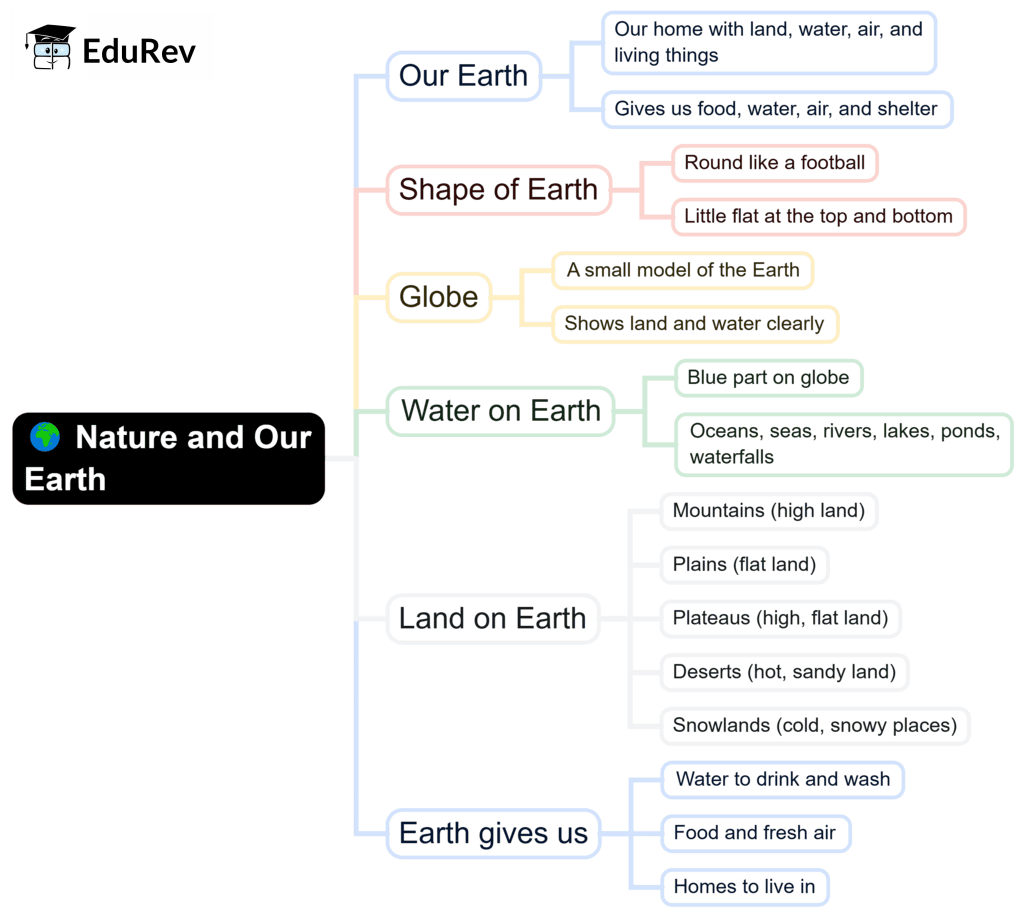Class 1 Exam > Class 1 Notes > EVS for Class 1 > Mind Map: Nature and Our Earth
Mind Map: Nature and Our Earth | EVS for Class 1 PDF Download

The document Mind Map: Nature and Our Earth | EVS for Class 1 is a part of the Class 1 Course EVS for Class 1.
All you need of Class 1 at this link: Class 1
|
33 videos|215 docs|44 tests
|
FAQs on Mind Map: Nature and Our Earth - EVS for Class 1
| 1. What are the different ecosystems found on Earth and their significance? |  |
Ans. Earth is home to a variety of ecosystems, including forests, deserts, grasslands, wetlands, and aquatic ecosystems. Each ecosystem plays a crucial role in maintaining the planet's health. For example, forests act as carbon sinks, absorbing CO₂ and providing oxygen, while wetlands filter pollutants and provide habitat for diverse species. Understanding these ecosystems helps us appreciate their interconnections and the importance of biodiversity.
| 2. How does human activity impact the natural environment? |  |
Ans. Human activities such as deforestation, pollution, urbanization, and industrialization significantly impact the natural environment. Deforestation leads to habitat loss and increased carbon emissions, while pollution contaminates air and water sources, affecting wildlife and human health. Urbanization disrupts local ecosystems, and industrial activities can result in habitat destruction and resource depletion. Awareness of these impacts is essential for promoting sustainable practices.
| 3. What are some key conservation efforts aimed at protecting our planet? |  |
Ans. Key conservation efforts include the establishment of protected areas such as national parks and wildlife reserves, laws and regulations to limit pollution and overexploitation of resources, and initiatives aimed at restoring degraded ecosystems. International agreements, such as the Convention on Biological Diversity, focus on preserving biodiversity and promoting sustainable development worldwide. These efforts are crucial for safeguarding the planet's natural resources for future generations.
| 4. What role does climate change play in altering natural ecosystems? |  |
Ans. Climate change significantly alters natural ecosystems by affecting temperature, precipitation patterns, and sea levels. These changes can lead to shifts in species distribution, altered migration patterns, and increased frequency of extreme weather events. Ecosystems such as coral reefs and polar habitats are particularly vulnerable, facing threats like bleaching and habitat loss. Understanding these effects is vital for developing strategies to mitigate climate change impacts.
| 5. Why is biodiversity important for the health of our planet? |  |
Ans. Biodiversity is crucial for the health of our planet as it contributes to ecosystem stability, resilience, and productivity. A diverse range of species ensures that ecosystems can adapt to changes and disturbances, maintain essential services such as pollination, nutrient cycling, and water purification, and provide resources for food, medicine, and recreation. Protecting biodiversity is essential for sustaining life and ensuring a balanced environment.
Related Searches





















